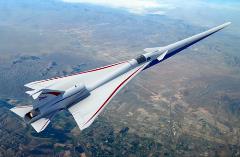Computational Aeroelasticity

Instructed by Dr. Walt Silva, Senior Research Scientist, Aeroelasticity Branch at NASA Langley Research Center, NASA Structures Lead for the Low Boom Flight Demonstrator (LBFD) X-59, AIAA Fellow. This 1-day short course covers concepts and terminology associated with aeroelasticity, including structural dynamics, unsteady aerodynamics, aeroservoelasticity, and recent developments such as computational reduced-order models.
Aeroelasticity consists of the modeling and understanding of the interactions between the structural dynamics and unsteady aerodynamics of a configuration such as an airplane, a launch vehicle, or a bridge. By its very nature, aeroelasticity is a multi-disciplinary field and can, therefore, include other disciplines such as controls (aeroservoelasticity) and thermal effects (aerothermoelasticity). Over the last few years, the field of aeroelasticity has been transitioning from its classical origins involving linear, frequency-domain methods to more modern, nonlinear, computational-based methods. The study and application of aeroelasticity involves the evaluation of critical loads and dynamics problems including, for example, gust loads and flutter. While flutter, a dangerous condition that can result in damage or destruction of the structure, is a serious safety concern that needs to be addressed, there are also other aeroelastic concerns that address the structural health and longevity, as well as performance, of the vehicle.
Learning Objectives
- Obtain a better understanding of several critical mathematical concepts
- Obtain a better understanding of the various unsteady aerodynamic theories
- Obtain a better understanding of structural dynamic principles
- Obtain a better understanding of aeroelastic principles
- Obtain a better understanding of aeroservoelasticity
- Obtain a better understanding of computational methods and reduced-order models
(Full Outline Below)
Who Should Attend
This short course provides a unified presentation of the various elements that are required for accurate aeroelastic and aeroservoelastic analyses. This unified approach clarifies and enhances understanding of unsteady aerodynamics, structural dynamics, aeroelasticity, aeroservoelasticity, and reduced-order models. Therefore, anyone interested in, or a practitioner of, anything related to aeroelasticity will benefit from the material provided in this course.
Course Information:
Type of Course: Instructor-Led Short Course
Course Length: 1 day
AIAA CEU's available: Yes
- Mathematical Foundations
- Classification of Systems
- Linear/Nonlinear and Time Invariant/Time Varying Concepts
- Deterministic/Stochastic, Stationary/Nonstationary Systems
- Influence Functions
- StateSpace Modeling
- System Identification
- Examples/Discussion
- Unsteady Aerodynamics
- Classical Methods
- Modern Linear Methods
- Computational Fluid Dynamics (CFD) Methods
- Examples/Discussion
- Structural Analysis
- Modal Analysis
- Finite Element Models
- Examples/Discussion
- Aeroelasticity (AE)
- Fundamental Concepts, Assumptions
- Equations of Motion
- Classical Solution Methods
- Modern Solution Methods
- Examples/Discussion
- Aeroservoelasticity (ASE)
- Definitions
- Rational Function Approximations
- Model Developments
- Examples/Discussion
- ReducedOrder Models
- Fundamental Concepts
- Method Development
- Applications
Dr. Walt Silva is a Senior Research Scientist and Engineer in the Aeroelasticity branch at the NASA Langley Research Center. Dr. Silva has more than 30 years of experience in industry, government, and academia in the fields of unsteady aerodynamics, structural dynamics, aeroelasticity, reduced-order models, nonlinear dynamics, and flutter testing. Dr. Silva has taught several invited short courses in aeroelasticity at national and international organizations. Dr. Silva is a NASA Floyd Thompson Fellow and a Fellow of the AIAA. He is also an adjunct professor at Old Dominion University and at the College of William & Mary. Dr. Silva has been awarded Patent 8060350, "Method of Performing Computational Aeroelastic Analysis", based on his Reduced-Order Modeling (ROM) technology. He is also the recipient of NASA's Exceptional Achievement Medal for his contributions in the development of nonlinear unsteady aerodynamic models. Dr. Silva is currently the NASA Lead for Structures for the Low Boom Flight Demonstrator (X-59).
AIAA Training Links
For information, group discounts,
and private course pricing, contact:
Lisa Le, Education Specialist (lisal@aiaa.org)
